For a quarter-century after being decommissioned, Iowa slept. In 1968, New Jersey was recommissioned for service off Vietnam, then decommissioned after a single tour because the North Vietnamese hated her too much and Washington wanted to send signals that they were interested in peace.1 In the 70s, several attempts were made to scrap the ship and her sisters, thwarted mainly by the efforts of the Marine Corps, who feared the loss of fire support capability these ships provided.2 These efforts began to gain support in the late 70s, and in 1980 a bill to release funds for a reactivation reached the Senate floor before being defeated thanks to the personal intervention of President Carter. Fortunately for Iowa, President Carter was himself defeated that November, and President Reagan announced that he would support the reactivation and modernization of all four Iowas.3
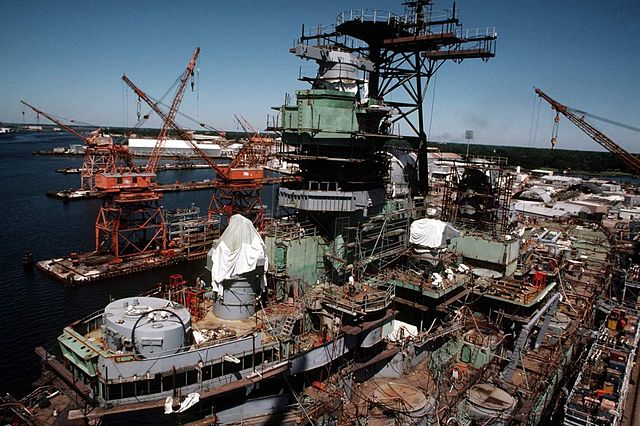
Iowa undergoing modernization at Pascagoula
Iowa was the second ship reactivated, following the New Jersey. Funds first were authorized in FY 82, eventually totaling about $385 million.4 She was towed out of Philadelphia on September 1st, 1982, and sent first to the Avondale shipyard in Louisiana and then to Pascagoula, Mississippi for final work. During this time, Iowa lost 4 of her 5" mounts, and gained 8 quad Tomahawk cruise missile box launchers, 4 quad Harpoon anti-ship missile launchers, 4 Phalanx Close-In Weapons Systems (CIWS) and a new suite of electronic warfare equipment. She recommissioned on April 28th, 1984, 9 months ahead of schedule. This acceleration was driven by the need to relieve the New Jersey off of Lebanon. Ironically, the Reagan administration dramatically drew down US presence in the region at shortly before Iowa recommissioned, and she didn't have to rush to the Near East after all.
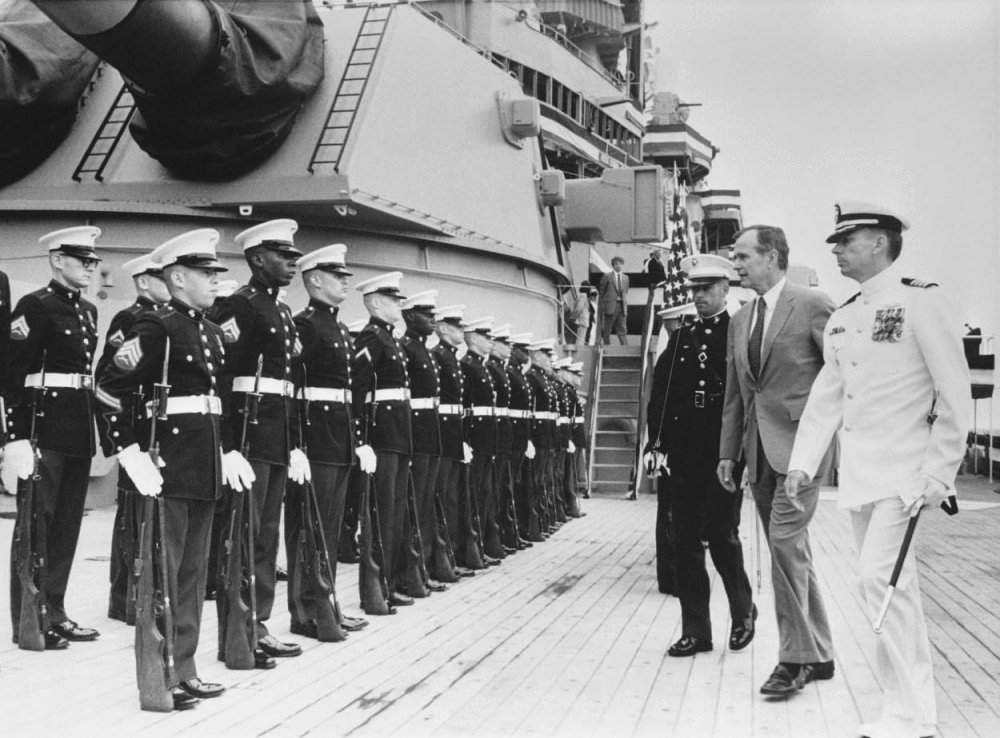
Vice-President Bush at Iowa's Third Commissioning
Iowa’s first deployment was a cruise through the Caribbean, participating in Operation UNITAS XXV, a multinational exercise in Venezuelan waters, gunnery exercises at Puerto Rico and Guantanamo Bay, and a visit to the Pacific coast of Guatemala, transiting the Panama Canal. When in US ports, open houses were held, most events attracting at least 10,000 visitors. In September, Iowa returned to Norfolk, her homeport,5 and spent the rest of the year training up and down the East Coast. Iowa’s main battery scored the third-highest of the 31 ships that did qualification firing at the Vieques Island Range in Puerto Rico in 1984, followed by her secondary battery in fourth.6
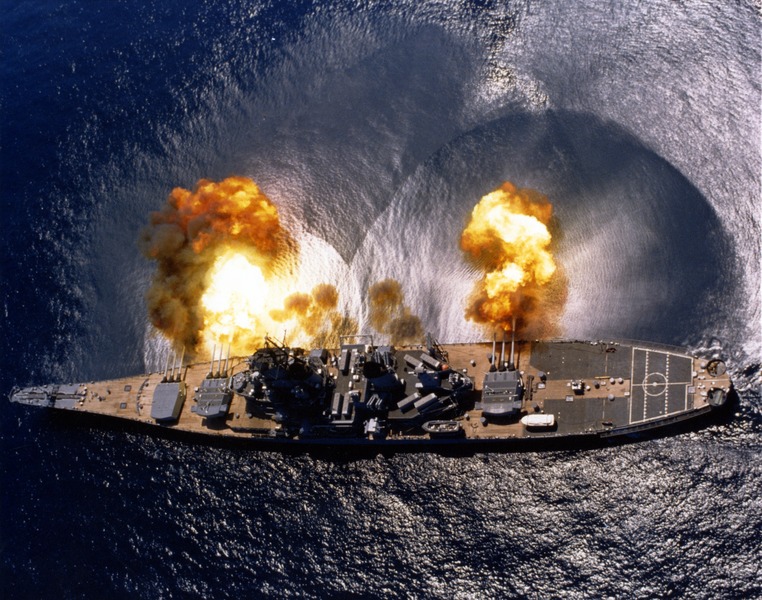
Iowa firing off Puerto Rico7
1985 started with more training, followed by a refit to correct the deficiencies found in the first year of service. She was widely recognized as a very good ship with a very good crew, culminating in the Battenberg Cup, an award given to the best ship in the Atlantic Fleet.
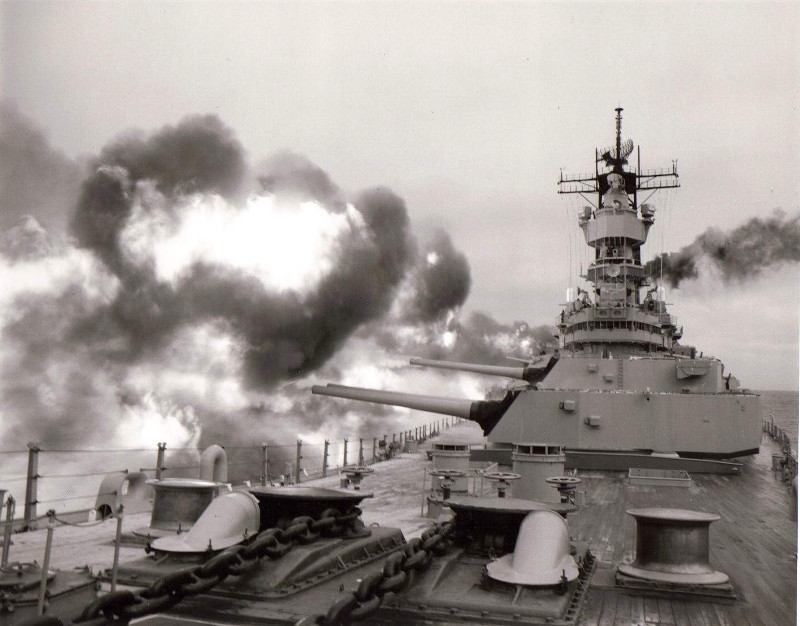
Iowa firing her guns during Ocean Safari
In August, Iowa participated in Exercise Ocean Safari, a test of NATO's ability to project power into the Norwegian Sea, threatening the Soviet bases in the Kola Peninsula. After Ocean Safari, Iowa visited Le Havre, Copenhagen, and Oslo. She then exercised in the Baltic and visited Kiel, former home of the German High Seas Fleet. By the time Iowa returned home in November, 102,401 people had visited her in various ports, not including VIPs.
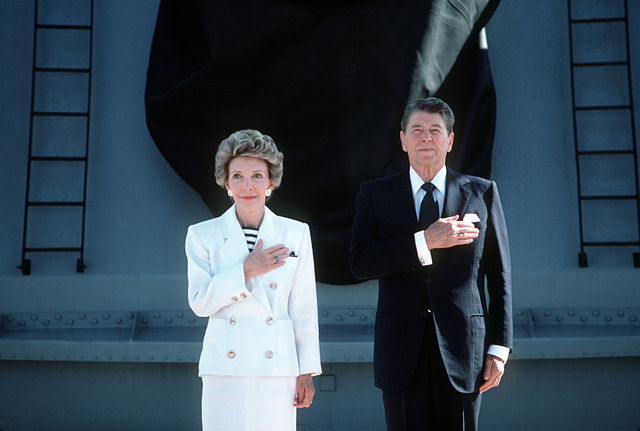
Ronald and Nancy Reagan aboard Iowa
Iowa made a second Caribbean deployment in early 1986, including a few more weeks in the Pacific. On July 4th, Iowa embarked President and Mrs. Reagan for the International Naval Review being held off New York to commemorate the 100th anniversary of the Statue of Liberty. In September, Iowa participated in Operation Northern Wedding, a NATO exercise similar to Ocean Safari.8 Port visits were made to Portsmouth, England and Bremerhaven, Germany. In December, Iowa became the testbed for the Pioneer UAV, the first drone operated in a reconnaissance role from a US ship.9 In the same month, she fired the 1,000th 16" round since the reactivation.
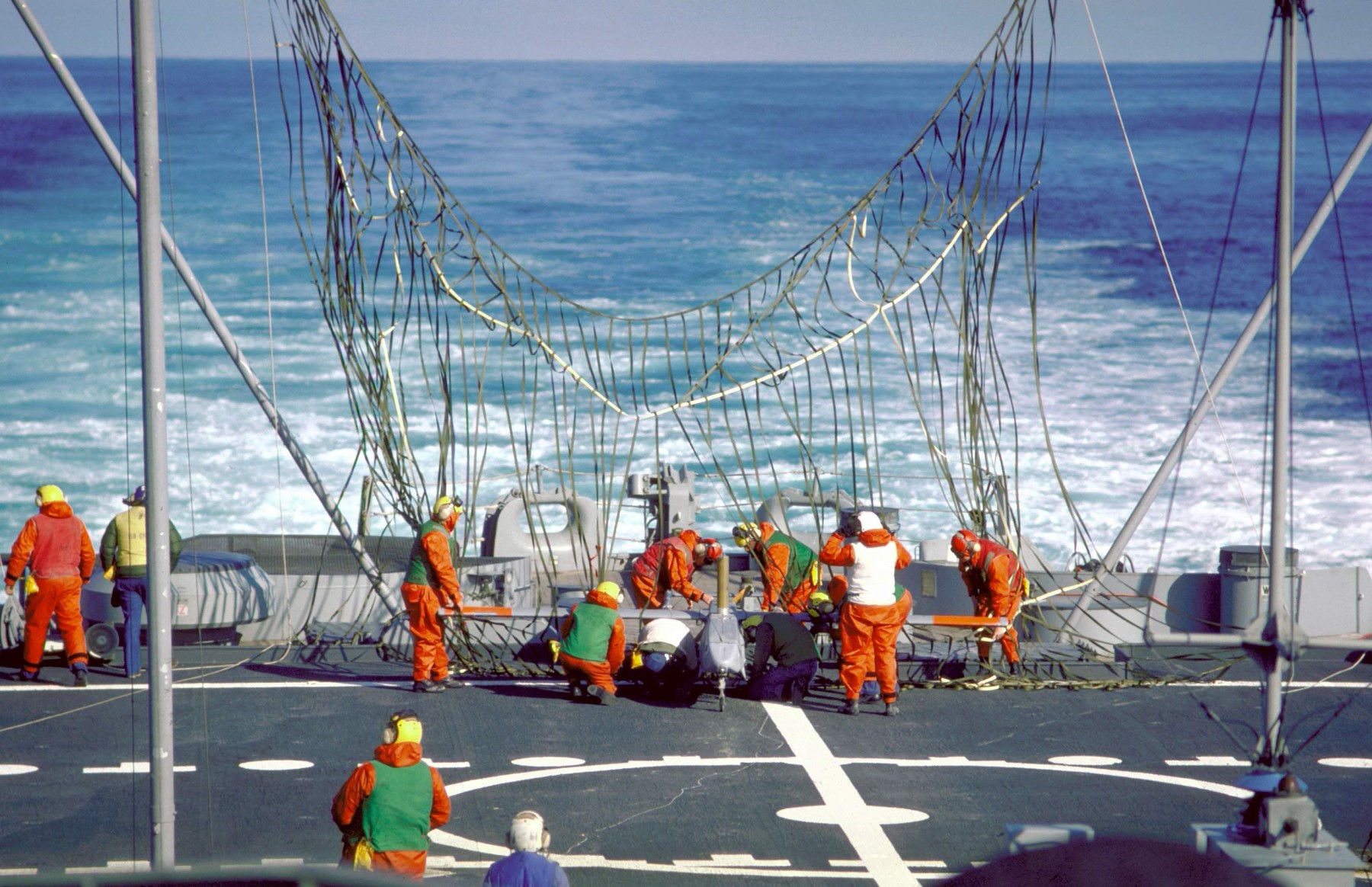
A Pioneer UAV being recovered aboard Iowa
A common task during the 80s was the firepower demonstration. This essentially consisted of bringing a bunch of VIPs out to watch the 16" guns shoot, to impress them with how powerful the US was. I'm told by everyone who ever saw it that it was extremely effective. Unfortunately, I'm not among those people, and doubt I ever will be.
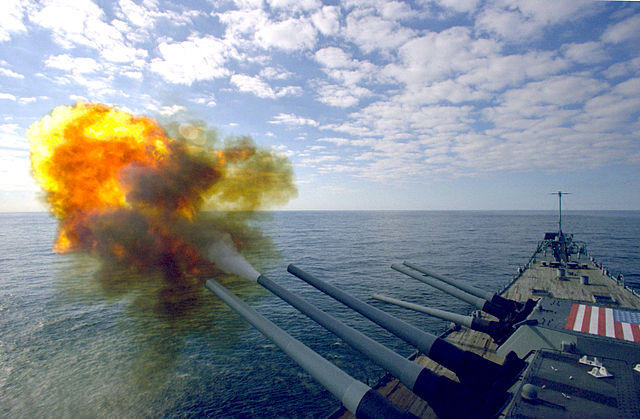
Iowa firing the 1000th round since reactivation
1987 began the same way 1986 had, with a trip to the Caribbean, this time in support of BLASTEX-87, another multinational exercise with the Latin American navies.10 Following more training and yard time in US waters, Iowa departed in September for a 6-month deployment to the Mediterranean. While there, she visited Naples, Istanbul, and Sicily. In late October, she was sent to the North Sea, visiting Trondheim, Norway. However, events in the Persian Gulf in November drew her back into the Mediterranean and through the Suez Canal for the first time in her career.
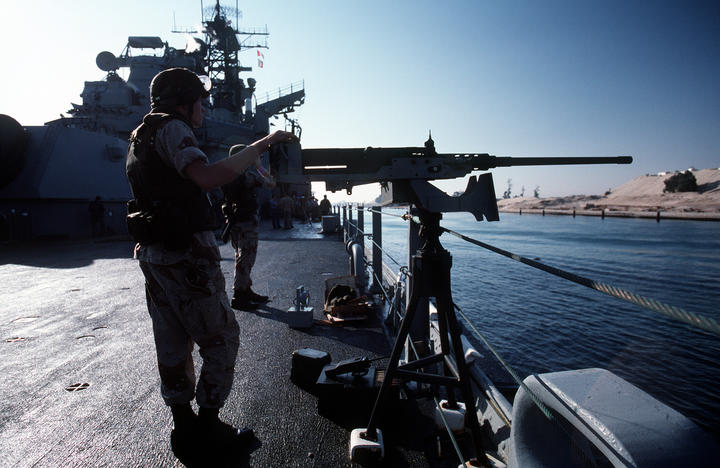
A Marine mans a machine gun as Iowa transits Suez
Iowa spent the last month of 1987 and the first month and a half of 1988 serving in Operation Earnest Will, the largest convoy operation since WWII. Missile attacks and mines had taken a serious toll on Kuwaiti tankers, until the US stepped in to escort them. Although there were attacks and US retaliation both before Iowa arrived and after she left, the Persian Gulf was quiet while she was there, and she never engaged the enemy.
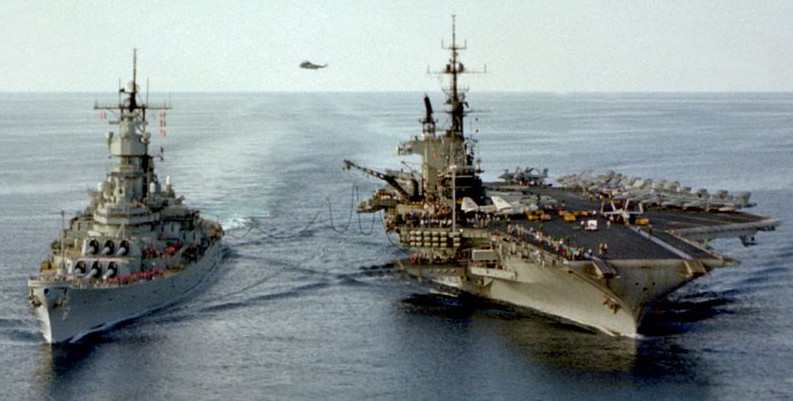
Iowa operates with USS Midway in the Arabian Sea
In late December, the Bob Hope USO tour visited the ships stationed in the Persian Gulf, including Iowa. Bob Hope performed, and the Dallas Cowboys Cheerleaders spent the night aboard. They were berthed in the sickbay, because it had private bathroom facilities and only one entrance, where a Marine guard was posted. Apparently, a quirk of the ventilation system spread their perfume and other scents throughout the ship, and many sailors could be found huddled near the air vents.11
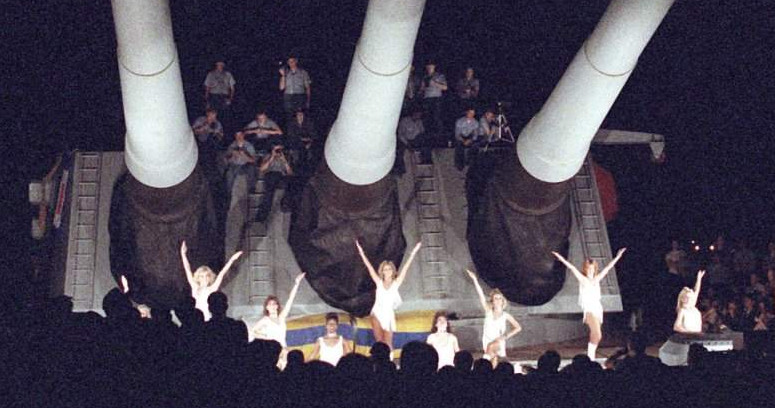
The Dallas Cowboys Cheerleaders performing aboard Iowa
Iowa returned to Norfolk in March, and participated in the New York Fleet Week in late April. From May to August, she was drydocked at Norfolk. The balance of the year was spent on the usual operations in the Atlantic. One notable guest was Tom Clancy, who spent a week aboard in September.
In January of 1989, Iowa's guns made the longest-range shot ever fired by a battleship, at 23.4 nautical miles (26.9 statute miles) off Vieques Island, Puerto Rico. It was a gunnery high point for the ship, and the battleship in general, but it all came crashing down in April.
1 I promise I am not making this up. This is the Vietnam War in a nutshell. ⇑
2 Another important supporter was the Chief of Naval Operations, Jimmy Holloway III, son of former Iowa captain Jimmy Holloway Jr. Some books erroneously report that CNO Holloway was a former captain of Iowa, due to confusion between father and son. ⇑
3 Not for quite the same reasons that the Marines supported it, but that's a matter I've covered separately. ⇑
4 $790 million in 2017. ⇑
5 Officially, Norfolk was the interim homeport until facilities were ready at Staten Island, New York under the Strategic Homeport program. In practice, this was a successful attempt to get Congressional votes for the reactivation and for naval strength more generally, and Iowa was deactivated before the facilities at Staten Island were ready. ⇑
6 Sorry, I don't know who was first and second. My source only says "the most modern ships", which might mean Ticonderoga and Yorktown at that point. ⇑
7 I know it's a cliche, but it's such a good photo I had to use it here. ⇑
8 According to her Captain at the time, Iowa managed to get within gun range of the blue fleet without being detected while operating as part of the "orange" force, although I don't have independent confirmation of this. ⇑
9 Apparently, in the early days, the drones were on loan from Israel, which meant that every time one was lost, there was a minor diplomatic flap. ⇑
10 Fighting communism in Latin America was a major plank of Reagan's foreign policy, so there was a lot of US military engagement in the region. This is a task the Iowas excelled at, as they were big and impressive, but cheaper to operate and in lower demand than aircraft carriers. ⇑
11 Ted Kennedy had visited a week previously, but for some reason, I don't think he got the same treatment. ⇑

Comments
Why did the North Vietnamese hate USS New Jersey so much? Because she was particularly good at shore bombardment compared to other commissioned vessels? (I guess this is feasible: did we have anything in commission with larger than 5'' guns? Wikipedia, alas, lacks a "list of US Navy vessels in 1967", but my reading of Friedman strongly implied we just had CG/DDG/FFG at that point, and I can't find any class through random sampling.) Or were their reasons for not liking it equally weird to our decision to acquiesce?
Nothing more complicated than New Jersey being a very effective gun platform. Because of how Vietnam is shaped, she was a particular problem to them. 80% of targets were within 16" range of the coasts. There were a couple of 8" cruisers still in service at the time, but their guns only had a range of 30,000 yards, and a 16" shell is a lot more destructive than an 8". They used to clear helicopter landing zones with 1 16" HC shell.
(As for anecdotal evidence, I was playing CMANO. After winning the Dong Hoi scenario, I got bored and edited the New Jersey in. That went a lot more quickly, compared to the couple of FRAM Gearings that I'd been using previously.)
I'm curious as to what it means for the Iowa to come in 3rd of 31 ships with her main battery and 4th with her secondary battery, when there were only four ships in the fleet for which "secondary battery" is a meaningful term.
The main and secondary batteries were treated as separate 'ships' by the people keeping score, and placed on the same scale as everyone else. Specifically, at the time the only other ship with a secondary battery in commission was New Jersey (Missouri and Wisconsin were still activating) and she wasn't using the Atlantic Fleet's firing range.
I find it amusing to imagine that as a compromise between "the scoring system is designed for ~3"-5" guns like normal ships have" and "why are we even here if we don't get to use the big ones", but have no reason to actually believe that.
What numbers I have for post-WWII long-range artillery accuracy (mostly land-based, and few/vague enough that I could easily be wrong about this) suggest that it stayed only about as good as an Iowa, so her genuinely out-shooting most of the fleet is not totally implausible, but I don't know if coming 3rd of 31 implies that or if it was handicap scoring.